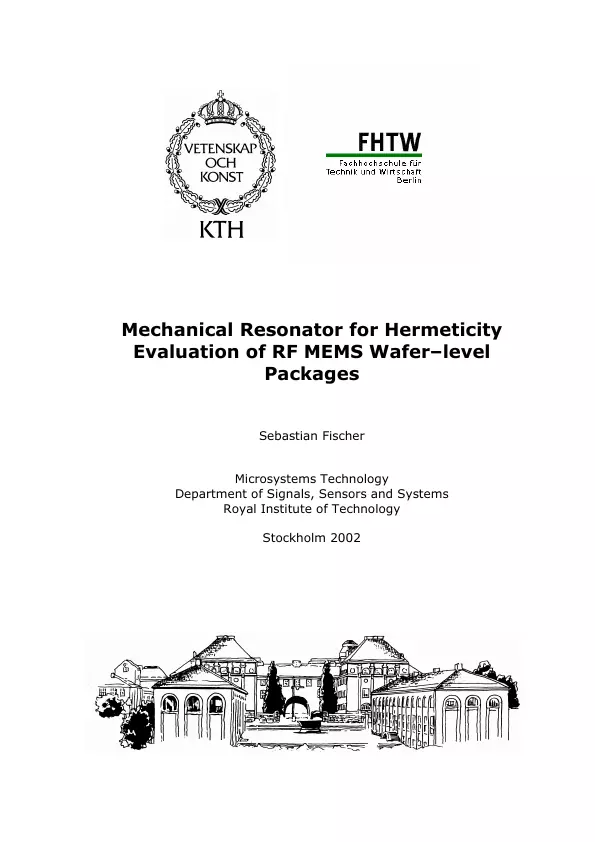Common test standards for evaluating the hermeticity of microsystem
packages are unsuitable for small MEMS-devices.
It is the task of this Master thesis to create a universal test device to
measure and to compare the hermeticities of different wafer-level
packaging concepts, especially for RF MEMS devices. Resonator structures
were found to be most suitable to measure low pressures and low
pressure changes over time, due to the high sensitivity of their Q-value to
the pressure in the cavity. The resonators are electrostatically actuated by
using a novel coupling concept of the excitation voltage. The detection of
the resonator movement is done by laser-interferometry. Sensors fulfilling
the specific demands were designed, simulated and fabricated in the
cleanroom. The fabrication process is based on SOI (Silicon On Insulator)
wafers. Finally, the sensors were evaluated and characterized.
A suitable resonator with a length of 500 µm reaches a Q-factor of 8070,
at an ambient pressure of 0,02 mbar, and a resonance frequency of
36329 Hz. The sensitivity of the Q-value to pressure change is
4000 %/mbar at 0,02 mbar.
This work was carried out within the Summit RF MEMS project,
a collaborative project involving Ericsson, the Royal Institute of
Technology-S3, Acreo and Saab Ericsson Space.
Inhaltsverzeichnis (Table of Contents)
- Introduction
- What is MEMS?
- Hermeticity
- Wafer-level sealing technologies
- Anodic bonding
- Silicon direct bonding
- Eutectic bonding
- Adhesive bonding
- How to measure hermeticity
- Theory
- Bending of a beam
- Mechanical vibrations
- Free, undamped vibration
- Flexural mode vibration
- Shear deformation
- Torsional vibration
- Longitudinal vibration
- Damping
- Quality factor
- Pressure dependency of the quality factor
- Electrostatic excitation
- Optical detection
- Fabry – Perot – Interferometer
- Optical properties of silicon
- Project management
- Design
- System requirements
- Design considerations
- Design Process
- Stiction
- Mode coupling
- Material
- Excitation and detection
- Electrostatic excitation of the beam
- Mechanical stability of the bottom-bottom electrode configuration
- Electrical connections
- Detection technique
- Designing a basic beam structure
- Design variations and other resonator shapes
- Mask drawing
- Fabrication
- Flowchart
- Measurement setup
- Measurement Results and Discussion
- Final Discussion and Conclusions
- Acknowledgments
- References
Zielsetzung und Themenschwerpunkte (Objectives and Key Themes)
This Master thesis aims to develop a universal test device for evaluating the hermeticity of different wafer-level packaging concepts, especially for RF MEMS devices. The work focuses on the design, fabrication, and characterization of a hermeticity sensor based on a resonant structure that is highly sensitive to pressure changes.
- Hermeticity evaluation of RF MEMS wafer-level packages
- Design and fabrication of a pressure-sensitive resonant sensor
- Characterization of the sensor's pressure sensitivity and Q-factor
- Electrostatic excitation and optical detection techniques for MEMS devices
- Optimization of sensor design and fabrication process
Zusammenfassung der Kapitel (Chapter Summaries)
The first chapter provides a comprehensive introduction to MEMS, hermeticity, and wafer-level sealing technologies. It covers various bonding techniques and discusses their advantages and disadvantages. The chapter concludes with a review of existing hermeticity measurement methods and highlights the challenges associated with testing small-volume cavities.
Chapter two delves into the theoretical fundamentals of the sensor's operation. It covers the bending of beam structures, the principles of mechanical vibrations, and the influence of damping on resonance behavior. It explores different vibration modes and their frequency dependency, as well as the relationship between pressure and the Q-factor of a resonant structure.
Chapter three outlines the project management plan for the master thesis, outlining the key activities, time schedule, and required equipment for designing, fabricating, and evaluating the hermeticity sensor.
Chapter four focuses on the design process of the sensor. It details the system requirements, design considerations, and simulation tools employed for the development of the device. It explores various structural designs, including single-clamped and double-clamped beams, paddles, triangles, and circular resonators, and investigates the influence of different geometrical parameters on their resonance behavior. It also discusses the challenges of stiction and mode coupling, the choice of materials, and the implementation of electrostatic excitation and optical detection methods.
Chapter five describes the fabrication process of the sensor, including the different processing steps involved in creating the silicon and glass wafers. It highlights the challenges encountered during fabrication, such as stiction, residue issues, and wafer fragility. It presents a detailed flowchart outlining the process steps and the key parameters used for each step.
Chapter six presents the measurement setup and results obtained for the fabricated sensor. It explains the electrical and optical contacts used to connect the sensor, the measurement system, and the data acquisition process. It describes the pressure-dependent resonance behavior observed in the sensor, highlighting its sensitivity to pressure changes in the low-pressure region.
Schlüsselwörter (Keywords)
The main focus of this master thesis is on the development of a hermeticity sensor for RF MEMS wafer-level packages. The project involves aspects of MEMS design, fabrication, and characterization, particularly exploring the pressure-dependent Q-factor of resonating structures. Key terms and concepts include: hermeticity, RF MEMS, wafer-level packaging, resonant sensor, Q-factor, pressure sensitivity, electrostatic excitation, optical detection, silicon, SOI wafer, DRIE, adhesive bonding, and micromachining.
- Quote paper
- Dr. Sebastian Fischer (Author), 2002, Mechanical resonator for hermeticity evaluation of RF MEMS wafer–level packages, Munich, GRIN Verlag, https://www.grin.com/document/21041



